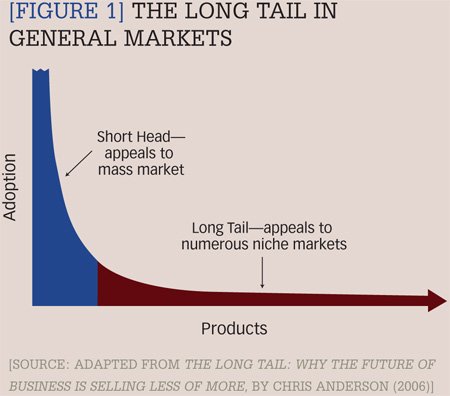Chasing After The Long Tail Of The Market

The Long Tail is a hypothesis made by Chris Anderson, which states that the internet will allow small-scale, niche markets to be viable and profitable. In the past, distribution channels were limited in scope to accommodate large-scale markets.
However, with the advent of the internet and e-commerce technology it is now possible for small companies to reach customers without having to invest in huge productions or physical retail stores.
This has led to a new era of niche markets where small companies can thrive on selling products that appeal only to smaller groups of people - known as "niches."
The Long Tail of the market
The long tail of the market is not as popular as the head, but it is becoming profitable.The head of the curve represents items that have high demand and low supply. These are the most popular products that sell in large volumes and make up a majority of sales. The middle part of the curve represents items with medium demand and supply. These are products that sell well enough to be profitable, but they don't sell as much as those in the head of the curve.
And finally, at the end of this diagram (which might look like a bell curve if you're drawing one) we have those items with low demand and high supply—these are not very popular because they aren't selling fast enough to cover costs or generate profit for producers or retailers selling them, and so few people buy them because they're more expensive than comparable products that may be on sale for less money despite being otherwise identical in quality.
Scale Versus Magnitude In Terms Of Market Profit
The long tail of the market is where ‘new’ businesses can make more money. In fact, it’s where most businesses are actually making their money. The mass market is over crowded and is not profitable enough to sustain a business on its own. You need to start thinking about going after your share of the long tail—the minority market that isn’t being served by others because they don't see it as an opportunity worth pursuing.
When it comes to scale, you need to sell a large number of product (or service) units to make a substantial profit, this is mainly because of the saturation of the market and the slim profit margins. The airline industry is a good example. That’s why they died during the pandemic. But they were revived back to life by the government. By default, the chances of achieving a substantial market profit on the head of the market are slim, unless you monopolize the market.
The difference between scale and magnitude is that with magnitude you don’t need to sell a large number of units to make substantial profits. Rather, you only need to sell some units to make substantial profits.
The reason is because there’s a huge gap between the actual cost and the perceived cost of the product/service. With the help of technology, the actual cost of production can be dropped to near zero. Couple that with serving a niche market and you begin to see how profitable the ‘long tail’ is. What would you charge in a niche market when the cost of production is near zero?
Technology Coming To The Rescue
Technologies like machine learning, artificial intelligence and blockchain are allowing brands to optimize their supply chains and more efficiently serve the underserved market. We’re also seeing super apps that are allowing smaller companies compete with bigger ones by aggregating all sorts of services in one place, like grocery delivery or ride-hailing through Uber Eats or Deliveroo.The internet has brought about a new era of niche markets. While most business owners have traditionally focused on the “long tail” of the market, producing large quantities of goods and services that appeal to a wide range of customers, now it is possible to reach niche markets and sell small quantities as well.
This is because in this new world you can use technology like ecommerce websites or social media to reach consumers worldwide. You don’t need physical stores or employees anymore; you just need your computer and an internet connection.
The internet has also made it possible for people who have never done business before to enter into industry sectors where they might not have previously been able to compete with established players—the barriers are lower than ever before due in part because there are fewer regulations governing how one may go about starting up an online company (or website).
In Conclusion
The Long Tail is a powerful concept that can be used to change the way you think about marketing. The idea that you can make more money by selling less stuff sounds like a crazy idea but it's true!With the internet and its ability to connect people from around the world, small markets are no longer limited by geography or language. As long as there is demand for what you're selling, there will always be someone willing to buy it—no matter how small their audience might seem at first glance.
*Source: https://www.supplychainquarterly.com/articles/236-the-long-tail-of-e-commerce-standards
Thanks For Reading!
Follow: Young Kedar
Recent Posts;
● Collaboration Versus Coordination In A Tech Driven World
● How Personal Finance Gives You An Edge In The Modern World
● Building Social Capital In The Attention Economy
● These Macroeconomic Trends Are About To Fall On Us
● Ways To Combat The Looming Recession
Dolphin Support : @cryptothesis
Posted Using LeoFinance Beta
 *
*